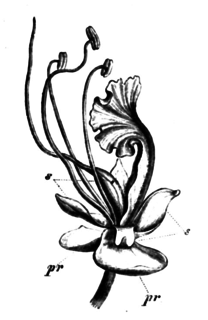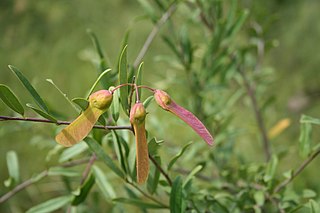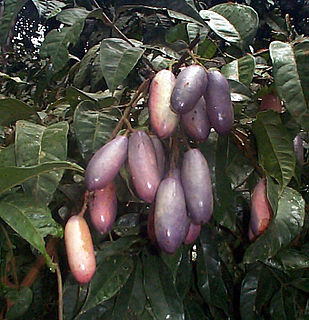
Bombacaceae were long recognised as a family of flowering plants or Angiospermae. The family name was based on the type genus Bombax. As is true for many botanical names, circumscription and status of the taxon has varied with taxonomic point of view, and currently the preference is to transfer most of the erstwhile family Bombacaceae to the subfamily Bombacoideae within the family Malvaceae in the order Malvales. The rest of the family were transferred to other taxa, notably the new family Durionaceae. Irrespective of current taxonomic status, many of the species originally included in the Bombacaceae are of considerable ecological, historical, horticultural, and economic importance, such as balsa, kapok, baobab and durian.

Schoepfia is a genus of flowering plants belonging to the family Schoepfiaceae. The genus has long been placed in the Olacaceae family though many researchers noted the differences between it and the rest of the family. Recent molecular studies have shown Schoepfia to be more closely related to the families Misodendraceae and Loranthaceae, and to uphold the criteria of monophyly it must be excluded from Olacaceae.

Macrolobium is a legume genus in the subfamily Detarioideae. It is a tropical genus with about 80 species. Half occur in Brazil, where they are common in the floodplains of the Amazonian Basin. Members of the genus are used as ornamentals and for their wood.

Swartzia is a genus of legume in the family Fabaceae. It was named in honor of Swedish botanist Olof Swartz and contains about 200 species. Swartzia is restricted in its geographical distribution to the New World Tropics, where it occurs primarily in lowland rainforests, but also in savannas, pre-montane forests, and tropical dry forests. While it can be found throughout the wet lowlands from Mexico and the Caribbean islands to southern Brazil and Bolivia, Swartzia is most abundant and species-rich in Amazonia, where 10–20 species may co-occur at a single site. The species of Swartzia are mostly trees, ranging from small understory treelets to large canopy emergents. Some species, especially in savannas, are mult-stemmed shrubs.

Arachnothryx is a genus of flowering plants in the family Rubiaceae. It contains about 107 species. It is found from Mexico to Peru and in Trinidad.

Olax is a plant genus in the family Olacaceae. The name derives from the Latin, olax (malodorous), and refers to the unpleasant scent of some of the Olax species.

Securidaca is a genus of shrubs and lianas in the family Polygalaceae. It is native to tropical Africa, SE Asia and the Americas from Mexico and the West Indies to Paraguay.
Remijia is a genus of flowering plants in the family Rubiaceae. Within the family, it is a member of the subfamily Cinchonoideae and the tribe Cinchoneae.

Dicymbe is a genus of 20 species of canopy trees in the family Fabaceae, within subfamily Detarioideae. It is found throughout the Guyana Shield region and parts of W Amazonia. Certain species within the genus are strongly associated with ectomycorrhizal fungi.
Heterostemon is a genus of flowering plants in the family Fabaceae. It belongs to the subfamily Detarioideae. It is usually green and often has white dots along its leaves.

Dacryodes is a genus of about 60 species of trees in the family Burseraceae. The generic name is from the Greek dakruon meaning "tear(drop)", referring to how resin droplets form on the bark surface.
Appunia is a genus of flowering plants in the family Rubiaceae. It was described by Joseph Dalton Hooker in 1873. The genus is found from southern Mexico, Central America, and northern South America.

Chomelia is a genus of flowering plants in the family Rubiaceae. It is native to Mexico, Central America, the West Indies, and much of South America as far south as Argentina.

Deppea is a genus of flowering plants in the family Rubiaceae. The genus is found in Mexico, Central America and from Brazil to northeastern Argentina.

Coussarea is a genus of flowering plants in the family Rubiaceae. The genus is found from southern Mexico to tropical America.

Pagamea is a genus of flowering plants in the family Rubiaceae, native to northern South America. Shrubs or small trees, they are specialists in the Amazonian white-sand forests.
Tapeinostemon is a genus of flowering plants in the family Gentianaceae, native to northern South America. It has microreticulate pollen grains, supporting its placement in the tribe Saccifolieae.












